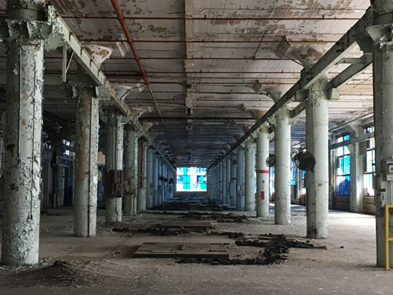From Brownfield to Mixed-Use Community Asset
Electric Works: Building a Place People Love
"We made a bold decision to venture into Electric Works, driven by our unwavering belief in the project's potential to become a significant asset within our community. This opportunity not only allows aspiring entrepreneurs to embark on their journey without requiring substantial capital but also presents the typical challenges that accompany any new business endeavor. As we approach our one-year milestone, we've encountered numerous challenges and embraced each one as a valuable learning experience for everyone involved." - Flora Barron, co-owner of Pikoso Burrito Co.How do 39 acres of abandoned brownfield become an award-winning innovation district? By asking what community members think of the new development, it is clear that Electric Works is building a place people love. History & Project
The campus was historically home to Fort Wayne Jenney Electric Light Company and eventually General Electric Co. It once employed a third of the City of Fort Wayne’s working population at its height in 1944. All activity left the campus in 2015, leaving the city to wonder what should be done with the 1.2 million square feet sitting vacant on the edge of downtown. Jump ahead to today, Electric Works is nearing it’s one year anniversary of opening Phase I, which includes the Do it Best Headquarters, retail space, the Union Street Market food hall, office and coworking spaces, a STEM-based high school, a restored recreation center, and various event spaces. Future phases include senior and non-age restricted affordable housing, a fitness center, and early childhood learning facilities. Finally, situated in the middle of the project is Dynamo Alley, a pedestrian-friendly street which can be shut down to vehicular traffic and has been utilized by a local farmers market. The result is a comfortable space for all users, and one that is adaptable to the community's interests and needs. Community Opinion
But what do community members and users of the new space think so far? Engaging with both business owners and high school students painted a picture of unity, innovation, and excitement. Riley, a high school student at Amp Lab, the STEM-based high school located within the development, commented on the synergy of the different users of the mixed-use project saying: “Everything is stronger together”. Another student, named Lily, said attending school here within Electric Works, “provides opportunities to make connections in our community while still in high school.” For example, the students were able to attend and engage with professionals and business owners in a symposium held by The City of Fort Wayne on small business and entrepreneurship, while taking a class on the same topic. The quote at the beginning of this article from an Electric Works restaurant owner, Flora Barron, speaks to her “belief in the project's potential to become a significant asset within our community.” These remarks get to the heart of mixed-use developments: the promotion of a sense of community and sense of place. National Award
The campus was designated this year as a federal historic site and is currently the largest adaptive reuse project in the state of Indiana. Shortly after, Electric Works was selected as a 2023 Phoenix Award winner, a national award recognizing exceptional brownfield redevelopment projects. Based on the 10 EPA Regions, the project was selected as the top project in Region 5 which includes: Illinois, Indiana, Michigan, Minnesota, Ohio, and Wisconsin. The criteria for this award is based on the project’s environmental remediation approach, regulatory compliance, redevelopment plan, positive impact (social/environmental/economic), and innovation used to bring the project to fruition. The last criterion alone recognizes the complexity associated with brownfield redevelopment.Take-aways
For Electric Works, a public-private partnership was necessary to take on such a large and complex project. It included multiple private developers, the City of Fort Wayne, Allen County, and the State of Indiana. This group approach also shows the importance of such projects, as each entity involved recognized the historical significance of the site and the health-related impacts of the site remaining vacant and contaminated. It was clear to every one of these organizations that the status of the site affects the health and well-being of all including the region, the city, the neighborhood, and the block. These are the building blocks of CNU.Brownfield sites are common in Midwestern communities, stemming from historic concentrations of manufacturing in the region. Inevitably, there are still many sites left untouched across the region and country. Most cities are aware of their designated brownfields, and can look to other projects, such as Electric Works, for a template on how to tackle such a complex development endeavor. Photo credits: https://www.inputfortwayne.com/features/ge-fort-wayne-spotlight.aspxAuthor Bio:
Elise Jones is an Economic Development Associate at Greater Fort Wayne Inc. in Fort Wayne, Indiana. She is responsible for assisting the economic development team in data collection, research, implementation work of various area plans, and conducting on-site business visits. She is a recent graduate from Ball State University, where she earned her bachelor's in urban planning and development through the College of Architecture and Planning, along with a graduate certificate in sustainability. She is interested in the intersection of adaptive reuse, sustainability, and public health.





